The secret of making Erb, wrapping paper (10 photos)
 Bashny.Net
Bashny.Net
You can try to make the paper itself)

The oldest known ebru was created in the 11th century. It shows that in this time of art reached perfection. According to scientists, to achieve the quality of this kind of art must have existed for several centuries. Art is so ancient that to this day there are disputes, where it originated. According to some assumptions ebru appeared in India, and then was taken over by the Persians, from which passed to the Ottomans, Turks current. According to other suggestions, it was born in Bukhara, and after it took over the Turks Iranians. One thing is for sure - ebru has oriental roots.

Just do not have the clarity and the origin of the name "ebru". There are several versions explaining the etymology of the word. Some suggest that the name comes from the Arabic «ab-ru», which translates as "water for the face." Others argue that most of the Chagatai «ebre», meaning "wave-like". Most agree on the fact that, rather, it is the name came from the Persian «ebri», which translated from Farsi means "cloud».
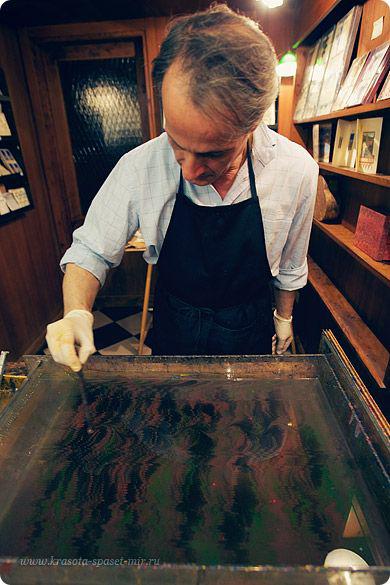
At first glance, it seems incomprehensible why so different in meaning of the word can define this kind of art, but knowing the technique of manufacturing ebru, everything falls into place. Indeed, whimsical background ebru has similarities with clouds, which, like fallen from heaven, left a unique imprint on the paper. Can also be said about the waves, which strikes us fancy transitions from one color to another. Not unreasonable and the assumption that ebru comes from the word that means "water face", because the manufacturing process ebru has direct contact with the water.
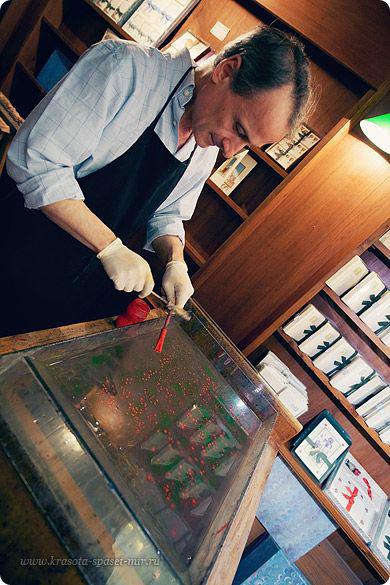
For the manufacture of ebru certainly need to have patience, because this process is time consuming, has several stages and is created using components that are significantly different in nature, but complement each other perfectly.
For the first stage in a small rectangular trough poured specially prepared thick solution of water and having weak adhesive properties gevena nectar (a plant of the genus Astragalus grows only in Turkey). Thus achieving the desired viscosity of water. Further, in this mixture is added natural paints that do not dissolve in water, and remain on its surface, mixed with each other and form a bizarre and unique patterns.
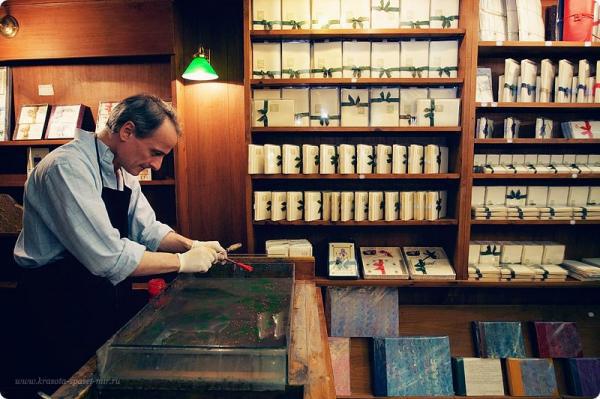
This mixture is applied paper and 5-10 seconds carefully remove and leave to dry. A unique backdrop is ready, but still it's not ready ebru. After the paper is coated with the background is dry, it will be assigned to the template with which will be applied to the main theme. And only then will the finished work will get its rightful name of "ebru».

If you have a description of this unique technology, which affects more background than the main theme, inspired by the fact, to try to create something similar to, the easiest way - to experiment with oil paints. To hold the paint on the water it is possible to add an office glue and oil or printed offset ink dissolved in skigeye. Next, proceed as described above. Maybe it will be a likeness of ebru, but what a pleasure to do something with their hands and know that your work is just as unique and impossible to copy it. In addition, set in a frame, your ebru perfectly fit into the interior, will be pleasing to the eye, and may even cause admiration.
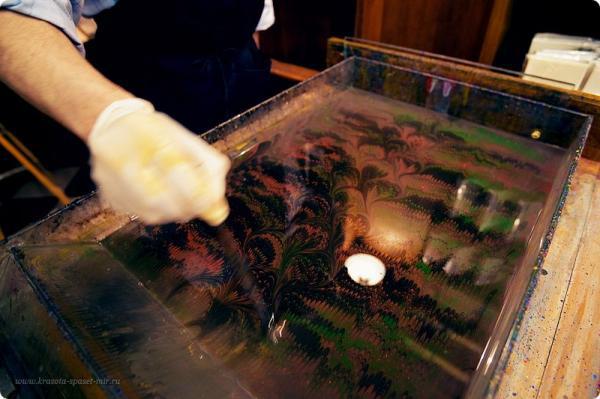

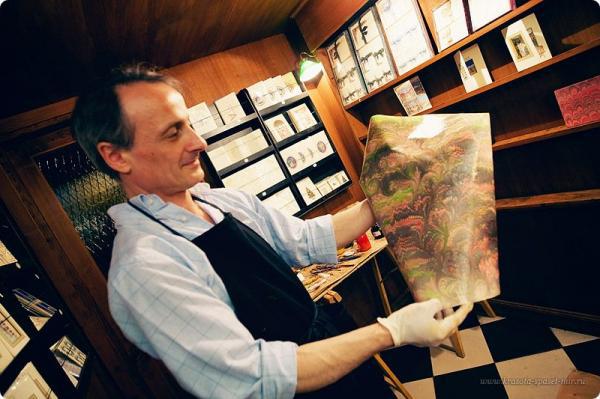
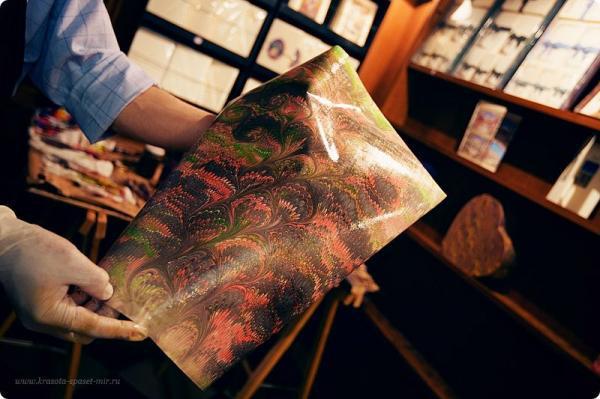

The oldest known ebru was created in the 11th century. It shows that in this time of art reached perfection. According to scientists, to achieve the quality of this kind of art must have existed for several centuries. Art is so ancient that to this day there are disputes, where it originated. According to some assumptions ebru appeared in India, and then was taken over by the Persians, from which passed to the Ottomans, Turks current. According to other suggestions, it was born in Bukhara, and after it took over the Turks Iranians. One thing is for sure - ebru has oriental roots.

Just do not have the clarity and the origin of the name "ebru". There are several versions explaining the etymology of the word. Some suggest that the name comes from the Arabic «ab-ru», which translates as "water for the face." Others argue that most of the Chagatai «ebre», meaning "wave-like". Most agree on the fact that, rather, it is the name came from the Persian «ebri», which translated from Farsi means "cloud».

At first glance, it seems incomprehensible why so different in meaning of the word can define this kind of art, but knowing the technique of manufacturing ebru, everything falls into place. Indeed, whimsical background ebru has similarities with clouds, which, like fallen from heaven, left a unique imprint on the paper. Can also be said about the waves, which strikes us fancy transitions from one color to another. Not unreasonable and the assumption that ebru comes from the word that means "water face", because the manufacturing process ebru has direct contact with the water.

For the manufacture of ebru certainly need to have patience, because this process is time consuming, has several stages and is created using components that are significantly different in nature, but complement each other perfectly.
For the first stage in a small rectangular trough poured specially prepared thick solution of water and having weak adhesive properties gevena nectar (a plant of the genus Astragalus grows only in Turkey). Thus achieving the desired viscosity of water. Further, in this mixture is added natural paints that do not dissolve in water, and remain on its surface, mixed with each other and form a bizarre and unique patterns.

This mixture is applied paper and 5-10 seconds carefully remove and leave to dry. A unique backdrop is ready, but still it's not ready ebru. After the paper is coated with the background is dry, it will be assigned to the template with which will be applied to the main theme. And only then will the finished work will get its rightful name of "ebru».

If you have a description of this unique technology, which affects more background than the main theme, inspired by the fact, to try to create something similar to, the easiest way - to experiment with oil paints. To hold the paint on the water it is possible to add an office glue and oil or printed offset ink dissolved in skigeye. Next, proceed as described above. Maybe it will be a likeness of ebru, but what a pleasure to do something with their hands and know that your work is just as unique and impossible to copy it. In addition, set in a frame, your ebru perfectly fit into the interior, will be pleasing to the eye, and may even cause admiration.




Tags
See also
Christmas wreaths from recycled materials
Moon 2112
Beautiful trash cans in Holland
After seeing these photos, you will try to do the same! Never, never would have guessed...
The most famous pictures subjected to Photoshop
7 WAYS TO IMPROVE average check
The original declaration of love
Removing Volvo
Lightsaber Jedi from "Star Wars"
Museum in Kuzminki
















